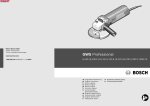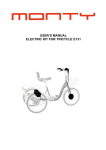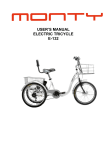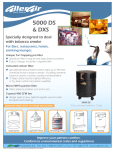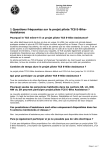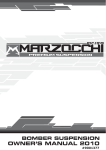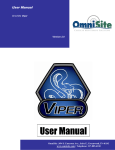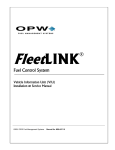Download DaaHub User Guide & Installation Manual
Transcript
DaaHub User Guide & Installation Manual Wisper Electric Bicycles May 2011 - 1st edition ©Copyright 2011 Wisper Ltd Contents 1 Introduction ..................................................................................................................................... 3 2 First Steps ......................................................................................................................................... 3 3 2.1 Charging the Battery ........................................................................................................ 3 2.2 Tools Required.................................................................................................................. 4 Wheel Installation ............................................................................................................................ 4 3.1 V-brake Version Front Wheel Installation: ....................................................................... 4 3.2 Disc Brake Version Front Wheel Installation:................................................................... 5 3.3 Anti-spin Elbow Installation ............................................................................................. 6 4 Dock Installation ............................................................................................................................... 8 5 Pedal Sensor Installation .................................................................................................................. 8 6 Handle Bar Components Installation ............................................................................................. 11 6.1 Motor Cable and Front Junction Manifold ..................................................................... 11 6.2 Cable Pouch .................................................................................................................... 12 6.3 Brake Sensor................................................................................................................... 13 6.4 Micro-throttle................................................................................................................. 15 6.4.1 6.5 7 8 Throttle installation ................................................................................................. 16 LCD Console .................................................................................................................... 16 Final Steps ...................................................................................................................................... 16 7.1 Performance test:........................................................................................................... 16 7.2 Final Checks .................................................................................................................... 17 Glossary .......................................................................................................................................... 18 2 1 Introduction Congratulations on purchasing your new DaaHub electric bike conversion kit. This manual provides you with installation instructions to get you up and running as quickly as possible. It is recommended that you also check out the DaaHub Installation Video on YouTube. Simply search ‘DaaHub Installation Video’ or go to… http://www.youtube.com/watch?v=jWSLemauPgU If you are familiar with basic bike maintenance, the procedures set out below should be fairly straightforward. However, if you have any doubt about the installation procedures, or your level of knowledge, you should consult a qualified bike mechanic at your local shop to assist with and/or inspect the installation. 2 First Steps Your DaaHub electric bike conversion kit comes in two separate packages: 1. the DaaHub front wheel motor, inside a wheel bag; and 2. the DaaHub conversion kit components, in a black box. Open the black DaaHub box and carefully spread the contents out on the floor of your workspace. The first thing you need to do is get the battery charging while you complete the installation. Important: your bike should not be used until the battery is fully charged. 2.1 Charging the Battery Plug your charger into a power point and turn the power point on at the wall. Turn the charger switch on. One light will show red (indicating the power is on) and the other will show green (the charge status light). Turn your battery upside-down and open the carry handle to reveal the fuse cap and rubber charger socket cap (see Figure 1). Pull open the rubber charger socket cap and carefully insert the charger plug. After a second or two, the green light will turn to orange, signifying charging has begun. Note: it is important that the charger is turned on before you plug it into the battery. This allows the charger to ‘read’ the battery to determine if charging is necessary. If you plug the charger into the battery and then turn the charger on, charging may not commence. Figure 1 When the battery is fully charged the light will turn green again and the charger fan will stop. Charging the battery will take about 4-5 hours from fully discharged, less if the battery is only partially discharged. 3 2.2 Tools Required Before you start the installation, make sure you have the following tools handy: an adjustable wrench (8mm-18mm available range), or separate 8mm and 18mm wrenches; nippers or strong scissors for cutting tape and clipping flexi-ties; a set of Allen keys (hex keys); and a medium Phillips-head screwdriver Ok, let’s get started. 3 Wheel Installation Carefully stand your bike upside-down, making sure it is stable and the handlebar components are not being damaged on the floor. Remove the front wheel from your bike as per your bike’s user manual. Note: if your bike has v-brakes or calliper brakes you will have to release them first to remove your wheel (refer to your bicycle user manual for instructions). It is a good idea to put your original bicycle wheel into your DaaHub wheel bag for safe storage after you have removed it. Hint: you may want to swap your original tyre onto your DaaHub wheel first, if you prefer matching tyres front and rear. The instructions for wheel installation vary slightly depending on whether your bike has vbrakes or disc brakes. 3.1 V-brake Version Front Wheel Installation: Remove the DaaHub front wheel from the wheel bag, loosen the axle nuts nearly to the end of their travel and carefully slot the wheel into your front forks. The motor cable should be on the left side (when the bike is upright) and the motor cable will be exiting downwards (again, when the bike is upright). Remove the rubber nut-cover, the anti-spin elbow (if in place), the outer washers and the thin final nuts (see Figure 2) and place them to one side. The standard round washer (second washer from elbow in Figure 2) will not be used in the installation. Figure 2 There are 3 anti-spin adjustment washers on each side of the motor axle (see Figure 3). Depending on the width of your forks, position these inside or outside the fork dropouts to fit the spacing between your fork dropouts. The thicker outside washer is always placed immediately inside the main axle nut. Figure 3 4 For example: if the motor has 1-2mm of free space on each side, position 1-2 anti-spin washers between the motor and the inside of the dropout on each side. It is good to have a slightly tight fit, so you have to apply a small amount of pressure to open the forks out to fit the motor. Note: with suspension forks it is important you use the adjustment washers to get the correct fit. If you need to apply too much pressure to open the forks, or the forks pinch together too much when you tighten the axle nut, this will affect the performance of your forks Carefully lower your DaaHub wheel into your dropouts, making sure the motor cable is on the left side (when the bike is upright) and that the motor cable will exit downwards (again, when the bike is upright). Tighten your DaaHub axle nuts very firmly (to 65Nm), then reinstall and calibrate your brakes (refer to your bike’s user manual for instructions). Important: if you do not have your bicycle user guide and/or are not familiar with bike maintenance procedures, then have your brakes and other associated wheel components checked by a qualified bike technician once you have completed your installation. For example, if you don’t have a torque wrench, or are not familiar with the pressure required (very firm) for 65nm, you will need to get your bike checked. Important: recheck and tighten your axle nuts after your first test ride, then again after 1 week, and every 2-3 months after that. 3.2 Disc Brake Version Front Wheel Installation: Remove the rubber nut-cover, the anti-spin elbow (if in place), the outer washers and the thin final nuts (see Figure 4) and place them to one side. The DaaHub front wheel comes with a 180mm rotor installed. If your original bike has a 160mm rotor, then you Figure 4 will need to purchase a 160-180mm adapter from your local bicycle store. If this is the case, either seek accurate instructions for installation, or have it installed by a technician (5 minute job). Carefully lower the DaaHub wheel into your dropouts, making sure the cable will exit downwards when the bike is upright and the cable will be on the left side (the same side as the disc brake unit). Ensure that the rotor slots correctly into the disc brake unit. There are 3 anti-spin adjustment washers on each side of the motor axle (see Figure 5). These are used to position the DaaHub wheel so it aligns with the disc brake unit and fits the axle width correctly. For example: if the motor has 1-2mm of free space on each side, position 1-2 anti-spin washers between the motor and the inside of the dropout on each side. It is good to have a 5 Figure 5 slightly tight fit, so you have to apply a small amount of pressure to open the forks out to fit the motor. Note: with suspension forks it is particularly important you use the adjustment washers to get the correct fit. If you need to apply too much pressure to open the forks, or the forks pinch together too much when you tighten the axle nut, this will affect the performance of your forks Refer to your bicycle user guide regarding the alignment of the disc callipers. For example, it is best to have the brake unit centred before installing the DaaHub wheel. This will allow fine adjustment of the brake unit in either direction once the wheel is installed. Important: only adjust your brakes if you have your user manual and are competent in bicycle maintenance. If not, you MUST have the brakes calibrated by a cycle technician to make sure your bike is safe to ride. Once you have an approximate alignment, with the suitable number of adjustment washers inside/outside the dropouts, tighten your axle nuts very firmly (to 65Nm) and check the alignment of your brakes. Important: if you don’t have a torque wrench, or are not familiar with the pressure required (very firm) for 65Nm, get your bike checked by a technician after installation. Hint: the most common adjustment washer pattern is one washer inside the dropout on the disc brake side and 3 washers outside on the other side. Try this first. Important: recheck and tighten your axle nuts after your first test ride, then again after 1 week, and every 2-3 months after that. Note: If you need to replace your 180mm rotor, the torque settings for the screws are 5nm. 3.3 Anti-spin Elbow Installation Now we will install the anti-spin elbow onto the right side of the wheel axle (the opposite side from motor cable), so that the elbow faces towards the rear of the bike (see Figure 6). The elbow, special washer, and nut fit on the axle outside the main axle nut. The main axle nuts should have already been tightened to the specified torque setting in the previous step. Figure 6 Install the anti-spin elbow (elbow to rear of bike), then place the thin anti-spin washer onto the axle over the elbow and finally twist on the thin axle nut. Note: in the original DaaHub YouTube installation video, the washer is shown being placed between the elbow and main axle nut. We have revised the installation to the above method i.e. the anti-spin washer should be placed between the anti-spin elbow and the outer (final) thin axle nut. Tighten the nut to firm finger-tightness (it will be fully tightened in a later step). You want the elbow firm, so it cannot wobble left to right, but can still rotate slightly on the axle, without too much pressure needed. 6 Retrieve the anti-spin arm clamp and adjustable arm (see Figure 7). Remove the adjustable arm from the clamp. Wind the arm out (turn the middle bar) until the arm is approximately in the middle of its adjustment range (about 1cm of exposed thread at each end). Make sure the thread is evenly exposed at either end of the middle bar. Open the clamp by turning the clamp adjustment tab Figure 7 anticlockwise until it fully unscrews and you can open out the clamp ring. Carefully place the clamp ring around your right fork (opposite side from motor cable), temporarily aligning the adjustable arm against the end of the anti-spin elbow to estimate the appropriate clamp height. Tighten the clamp by turning the adjustment tab clockwise. Be careful with the first turn as the clamp ring screw needs to grip back into the adjustment thread to begin tightening the clamp. Tighten the clamp to firm finger tightness, so it locks tightly onto your fork Hint: you may want to use a piece of the supplied DaaTape to cover your forks under the clamp to avoid scratching. You are aiming to get the mount points at either end of the adjustable arm aligned with the holes on the end of the elbow and the clamp ring tab respectively (something like Figure 6). In addition, you want to avoid the adjustable arm contacting the fork (more of a potential problem with large diameter forks). To get the best ‘fit’, you will need to adjust the position and angle of the clamp ring, possibly reversing the direction it is mounted. Try attaching the adjust arm to the anti-spin elbow while you are finalising the alignment. Once you are happy with the general position and alignment, use a small Allen key to tighten the adjustment tab on the clamp ring half a turn so the clamp is tight. Generally the best fit for the adjustable arm at the other end will be on the final hole at the end of the anti-spin elbow. Important: do not over-tighten the clamp as it may break! It only needs to be tightened slightly past firm finger tightness. Install the adjustable arm onto the clamp by inserting the supplied screw through the clamp adjustment tab centre hole and then the end hole of the adjustable arm, then tighten the lock nut until the arm can still turn with light pressure, but does not wobble. Align the other end of the adjustable arm with the appropriate (best aligned) end hole on the anti-spin elbow (if not already in place). Adjust the length of the arm to line up the holes and then attach the arm to the elbow with the supplied screw and locknut. Tighten the nut just enough so there is no wobble. Turn the middle piece of the adjustable arm with your fingers (shortening the arm) until the anti-spin elbow is just pulled around tight. Then use a small Allen key to give the adjustment bar another half turn. Important: do not over-tighten your adjustment arm as you could damage your forks and make your bike unsafe to ride. Tighten the outer thin nut firmly (to 40 Nm). Your DaaHub front wheel is now installed. 7 Dock Installation With the bike still upside-down we will now install the main dock. Depending on your frame style and personal preference you can either mount it inside the frame (in most standard diamond frame hard-tail bikes) or behind the seat post (see figures 8 and 9). The seat post option is the most widely compatible option. Remove the dock from your component box along with the three pairs of rubber sleeves. Choose the appropriate diameter sleeve for your frame / seat post tube diameter to ensure a snug fit when tightened. Figure 8 Using the special Allen key supplied, remove the four screws for the dock to release the clamp. This special head pattern is a security feature to prevent the dock from being easily removed by a third party (make sure you store it in a safe place you will need it if you ever want to remove the dock). Insert the selected sleeve into the dock clamp and install the dock onto the appropriate part of your bike and re-install the four screws. Figure 9 Hint: The two male battery terminals should be to the top of the dock. Make sure you leave enough room above the dock for the battery. Note: If mounting within the frame, some bikes may have the front derailleur cable in the same area. It is ok to mount under this, even if the cable has to stretch to go over the clamp. You will just need to readjust your cable tension after installation is complete. If the cable fit is very tight, you may want to file a small cable guide into the edges of the clamp to help it and avoid cable damage. Only fasten the screws slightly at this stage so the dock will not wobble, but can still easily be rotated left to right. Also ensure that the screws are tightened evenly so the gap between the clamp and dock is fairly similar for each screw. 4 Pedal Sensor Installation The DaaHub kit uses a pedal cadence sensor to sense when you are pedalling and trigger the motor for Pedal Assist Mode (6 levels available from your console). The kit comes with two sensor mount options to maximize compatibility with all bikes: 1. Rear horizontal mount. This mount simply fastens around your rear left horizontal fork (close to the bottom bracket) with a flexi-tie and is the most common mount used (Figure 10). 8 Figure 10 2. Bottom bracket mount. This mount is fastened to the underside of your bottom bracket using the double-sided adhesive and DaaTape supplied (Figure 11). The sensor mount has two holes at one end so the sensor can be fastened to it at two different heights to allow for varying bottom bracket diameters. Choose the position that matches the sensor best with the magnet diameter. Figure 11 Choosing the Appropriate Mount One mount will be attached to the dock cable and the other will be attached to the spare pedal sensor/cable. Retrieve both the mounts/sensors and the DaaHub 2-piece magnet disc. Note: the dock comes with about 300mm of pedal sensor cable exiting the dock. There is another 300mm available inside the dock. The amount of cable you will require will depend on the size/style of your frame and your mounting position. If you need more cable to get the sensor down to your axle area, lightly pull the cable to draw more cable out. Clip the 2-piece magnet disc onto your left (when bike upright) side axle, between the pedal and bottom bracket, with the Wisper logo outwards. The 2-piece disc avoids the need to remove your crank to install the disc. If the disc is a slightly loose fit, you may use flexi-ties around the crank outside the disc to prevent horizontal movement (see Figure 12). In most cases this won’t be required. Note: If you have a hollow crank axle, you can break out or Figure 12 trim the inner fins on the disc for the bigger diameter. You can then use a small file to better shape the disc to fit around your left crank if need be. Hint: as an alternative, you can also glue the disc to the inside of your inner chain ring on the right side and install the bottom bracket sensor to match. Be sure to check your disc is the correct way before permanently fastening it. To test this, wait until your kit is fully installed and battery charged, the test it in assist mode level 1. If pedal assist mode triggers only when you pedal backwards, then flip your disc over before gluing! Using the above pictures and description as a reference, temporarily place both sensor mounts in their designated positions and decide which is the most suitable for your bike. Note: the sensor should be approximately 2mm from the magnets in the disc. Once you have decided the best mount follow the specific instruction below. 9 1. Rear horizontal mount. Use one of the supplied small-sized flexi-ties to insert through the mount holes on the sensor plate, then fasten the sensor to the appropriate part of your rear horizontal so it is aligned with the disc and pointing the same direction as in the pictures. Hint: if you think of the sensor as an arrowhead (cable behind it), then it points in the opposite direction of rotation when the pedals are moving the bike forwards. Figure 13 Hint: On some frames, where the weld of the kickstand mount to the horizontal is close, this ‘bump’ may force the flexi-tie to creep forward on the horizontal, so you may want to install a second flexi-tie looping through the first, then back along the horizontal and thru the kickstand mount. Apply the correct tension, so this second tie pulls the sensor mount back along the horizontal and hence back in line with the magnets. Bike frames vary considerably, and some will take a little more trial and error to get the mount point right than others. You can also use DaaTape to bind the sensor in place on the horizontal if need be. It can still sensor the magnet disc through a few layers of tape. Hint: later, when you test the system and all is okay, you can use more flex ties, or DaaTape to tidy the sensor cable against the seat-post tube frame. 2. Bottom bracket mount. Decide the suitable position on the bottom bracket to fasten the mount (normally on the underside). Hint: the mount is semi flexible so you can bend it to get the best fit to the curve of your bottom bracket. Clean the bottom bracket with a damp cloth, and then polish dry with tissue. Cut a suitable sized piece of the double-sided adhesive to Figure 14 fasten both mounting ‘feet’ then the peel the backing paper and smooth the tape onto the appropriate part of the bottom bracket (see Figure 14). Carefully peel the topside paper. Carefully set the mount onto the adhesive strip. Check your 2mm gap to the magnet disc then remove the disc to make the next steps easier. Cut another strip of double sided tape and repeat the above process to lay it over the mount feet. Then cut a 250mm length of DaaTape, peel the backing paper and carefully wrap it over the mount and around the bottom bracket (fully cleaned by now!), keeping good tension, and being careful to keep it on the bottom bracket and not let it slip over the edge. Wrap it around again and back over itself. Finally, smooth the tape down to make sure it is properly stuck. 10 Figure 15 Note: DaaTape is of a very high quality, and is semi flexible to allow for the irregular bind sometimes needed to fasten the mount properly. It is ok to curve it up over the curve of welds, etc. Key points are that your surface is clean and you keep a good tension as you wind it. Hint: keeping the tape tight and continuing to ‘pull ahead’ as you wrap it around makes for a stronger application. 5 Handle Bar Components Installation Carefully turn your bike upright again and lean it against a wall or lower the stand if it has one. Unfold the motor cable and main component cable from the underside of the dock and remove any twists. 5.1 Motor Cable and Front Junction Manifold Plug the motor cable into the motor, making sure that the arrows on both plugs align so that the pins are in the correct position when you insert the plug. (figure 16) Once you are sure the arrows and pins are aligned properly, the plug should be pushed firmly in, up to the marker line. Important: should you need to unplug the motor cable to fix a puncture, you must be very careful when plugging it in again that the arrows line up, otherwise you could seriously damage the plug. Figure 16 The motor cable should be exiting downwards and to the rear of the bike, as per earlier instructions. Use DaaTape or a flexi-tie to fasten it to your fork. Use the double-cable clip to parallelattach the motor cable to one of the bike cables above the forks, e.g. the front brake cable (see Figure 17). You will have excess motor cable between the forks and the dock which will be tidied away in a later step. Run the main cable from the dock up to your handlebar and decide the position you want to install the front junction manifold. 11 Figure 17 Note: the most common positions are under the centre of the handle bar (Figure 18), or to the side of the head tube (Figure 19). The first option is best, as the cables move with the handlebars. Figure 18 Figure 19 Once you have decided your front junction manifold mounting position, bend the semi flexible mount on the back of the junction box to the appropriate angle. Next, cut a suitable length of double-sided tape and fasten it to the frame/headset stem where the junction mount plate will go. Make sure you clean the frame surface before applying the tape. Peel off the surface paper then carefully apply the mount onto the adhesive. Cut a suitable length of DaaTape and bind the mount firmly to the frame (Figure 18). Note: there is also a 1 1/8 head tube-mounting component. (Figure 20) To use this option, remove the existing mount from your front junction manifold and install the 1 1/8 head tube mount. Next remove the headset and desired number of spacer rings (refer to your bicycle user manual), install the mount and then reinstall your headset and handlebars as per your user guide. Figure 20 5.2 Cable Pouch Now we need to tidy away the excess motor and main cable between the dock and front of the bike. Retrieve the cable pouch and install it on a suitable part of your frame with the Velcro straps, then carefully fold the excess cable into it and fasten the Velcro edges and strapping (Figure 21). Make sure you install the pouch inside any brake/gear cables. 12 Figure 21 5.3 Brake Sensor The magnetic brake sensors are applied to your existing brake levers so that the system can register when the brakes are applied. Retrieve the brake sensors, DaaCube mounts and magnets. The magnet is the separate cylinder shown in Figure 22 Figure 22 inserted into a DaaCube. The flat end (non-concave) of the cylinder has the magnet. The DaaCube is a rubber mount that allows the height and angle of the magnet (or sensor) to be changed. The sensor (shown on the left in Figure 22) is attached to a cable, which connects to the front cable manifold. The sensor and magnet need to be placed along the line of the main brake lever, so they meet where the lever butts against the main body of the brake unit and the end of the sensor and the magnet just touch when the brake is not in use. Then when the brake is applied, a gap is created between the sensor and the magnet and the safety cut-off feature is triggered. There are two options for mounting the brake sensors to your levers. 1. DaaTape The first and simplest option is to use the double-sided adhesive and DaaTape. This is the best option for most bikes. 2. DaaCube On bike with minimal lever movement (high- end hydraulics, etc.) or large height differential between lever mount point and sensor mount point you may need to use one or both DaaCubes per installation. The DaaCubes are used to raise the height of the sensor or magnet to get good alignment with the opposite magnet/sensor. DaaCubes also remain easily adjustable after application for fine-tuning the sensor gap. Note: On some bikes it may be best to use both options (see figure 23). In this bike we used DaaCube installation for the lever side (to minimize lever space taken and allow an ‘overhang’ of the magnet onto the main body where the sensor is mounted and we used DaaTape installation on the sensor side (also with one of the wedges (see below instructions) fixed underneath the sensor with double-sided tape to get the required alignment). Figure 23 DaaTape installation option: Hint: We recommend applying the sensor / magnet to the underside of your brake lever so it is out of sight. If you wish to do so, carefully turn your bike upside-down, making sure that you do not damage any of the handlebar components on the floor. 13 Figure 23 Choose the position of the sensor and magnet, with the sensor on the main part of the brake lever and the magnet on the lever arm. Remember the spot and apply double sided tape to both sides of the lever (the sensor and the magnet positions) then lightly stick the sensor and magnet to the tape. Apply the brakes and check there is a zero to 1mm gap when the brakes are not in use and a 5mm+ gap when the brakes are fully engaged. Once you are happy with the positioning, cut suitable lengths of DaaTape and fasten the sensors. Use two parallel strips on the sensor and magnet. Hint: if you are unsure your gap is correct you may choose to leave the final DaaTape application until your battery is charged and you can performance test before permanently applying the units. Plug the sensor into the main cable via the front junction manifold and the appropriate twopin receptor. Be careful to align the plug correctly to the socket as you plug it in. Repeat process for the other side brake DaaCube Installation Option Carefully remove your DaaCubes and the small wedges from their bag. Place the wedges somewhere they will not get lost. The DaaCube has a cone-shaped tunnel thru it, so you can place a wedge above, or below, the magnet/sensor, to alter its angle up or down. Also, depending from which side you insert the magnet/sensor, you will get different amounts of height adjustment. (Figure 25) Insert magnet and sensor into the DaaCubes then position them on your brakes and adjust the angles, insertion direction, etc., until you get a good proximity of sensor and magnet. Figure 25 Insert the wedges and push in further with a small Allen key to lock the magnets/sensors in position. Next loop two small flexi-ties though the base slots in the DaaCubes (but keep them open), then reposition the cubes and sensors/magnets on the designated spots on the brake lever. Carefully loop one of the flexi-ties around and through its zip lock and pull it so it is lightly tight. Do the same for the other, then alternated tightening each one until you have a firm final hold. Repeat the process for the other cube. Fine-tune the magnet/sensor gap so it is 0-1mm when the brake is not in use and 5mm+ when brake is in use. Note: if you prefer, you can also further bind the DaaCube with DaaTape. Note: as mentioned earlier, it may suit your bike best to use DaaCube on the magnet side (lever side) and DaaTape on the sensor side. 14 5.4 Micro-throttle The micro-throttle is best installed on the right side of the handlebars; with the LCD console the left side. The preferred position of the micro-throttle is over the right brake lever mount ring, adjacent to the right hand grip. The micro-throttle has adjustable aluminium mount plates that can be bent and also faced inwards or outwards and slide-adjusted (the screw fastening holes on the mount plates are oval) to ensure the best fit Figure 26 (see Figure 27). The mount plates have 3 mounting holes, two of which you thread the cable-ties though to attach the unit to the bike. Note: brake mount rings vary in shape considerably. However, with a little patience, you will get a good fit on all styles. Position the micro-throttle over your right brake lever handlebar mount. Observe how the micro-throttle sits onto the curve of the handlebar and rotate and or bend the micro throttle mounts until you get a good fit. Figure 27 Next insert two small flexi-ties through the outer holes of both mounts (so each flexi-tie will pass through both mounts, one on the left side of the throttle, one on the right side) then reposition the micro-throttle onto the appropriate position on the brake lever mount ring on the handlebar. Loop the ties around the handlebar (one on each side of the brake lever mount ring) and back through the zip locks. Lightly tighten each tie, alternately applying more tension to each, until the micro throttle has the correct alignment and will not slip when you operate the buttons. Hint: if you find it difficult to get the throttle firm enough not to slip, remove the unit (cut your flexi-ties), then apply a suitably placed piece of double sided adhesive tape and then reapply two more cable-ties. Hint: you can also use DaaTape to bind around the edge of the micro throttle, then around the handlebar. Clip the ends off the flexi-ties, then plug the micro-throttle into the appropriate plug in the main cable, being careful the plug and socket align correctly before you insert them. Note: you can use one of the supplied cable links to attach the micro throttle cable neatly to the brake cable, or can use a little DaaTape if you prefer. 15 5.4.1 Throttle installation DaaHub also comes with a standard throttle. If you prefer you can install this instead of the micro throttle, but a throttle is less compatible with gear shifters, and can get in the way of smooth gear operation. Note: even though it may take a little bit of getting used to initially, the micro-throttle is the best option for compatibility, simplicity and ease of use. Figure 28 Note: you will find you will mostly use the 6 levels of Pedal Assist anyway, just using the throttle when you need instant extra boost. To install the standard throttle, remove the left hand grip and slide the throttle on, then tighten the hex screw. Slide the plastic ring on, then the handgrip end piece. Hint: to free up your gear shifters, you can also install the throttle on the outside end of your right handgrip. However, for this type of installation, the cable is more vulnerable (as it is now on the outside) and you have to bind it along the inside of your brake lever to keep it out of the way. You also need to cut a short section of your original handgrip to insert inside the throttle to give you a full handgrip. 5.5 LCD Console Install the LCD console on the left side of your handlebar. Simply unscrew the bracket screw to open the bracket, and slide the unit as close to the left hand grip as possible before tightening the screw. Note: on larger diameter handlebars you will have to push firmly while you turn the screw to get it to thread in, or you may even need a longer compatible screw (but don’t get one too long otherwise you may damage the LCD when you tighten it) Figure 29 Plug the cable into the matching five-pin plug on the front junction manifold, being careful the plug and socket line up in the correct fashion before inserting. Tidy any loose cable as necessary, using cable links or DaaTape. 6 Final Steps Wait for your battery to fully charge then install it onto your bike and performance test all your components. 6.1 Performance test: 1. Make sure the battery key is turned fully anticlockwise to the ‘open’ position (push it to turn it if it is locked in the ‘off’ position). Once you are in the ‘open’ position, slide the battery fully onto the dock (its front edge will be touching the dock edge 16 2. 3. 4. 5. 6. when it is fully engaged), then turn the key fully clockwise until it is in the ‘on’ position (horizontal). Press the power on button on your LCD console and the screen should boot up, temporarily showing the wheel diameter (you can change the wheel diameter by holding the set button for 10 seconds, then use up / down buttons) Mount your bike (you must be outside, in a ride-able area, for these next steps). Use the up button to change the PA level to 1 bar. Carefully ride away and after about one pedal turn you should feel the assist power begin. Lift to level 2, 3, etc. to get more power. If assist does not happen then test the throttle (as below). If throttle works (but pedal assist does not), then it will be your pedal sensor that needs checking. Return to the relevant installation instructions and recheck you gap is correct etc. If both the throttle and the pedal assist function do not work, then recheck your brake sensors, as one of the gaps is probably too big and the safety feature has cut the motor off. Brake sensors. While you are in assist mode, apply your left brake and the motor should cutout. Repeat the process for your right brake. If the motor does not cutout, return to your sensor instructions. Either your sensor is not fully plugged in, or the gap when brakes are engaged is less than 5mm. Micro Throttle. Once the brakes have been tested and perform ok, you can test the micro throttle. With pedal assist to level 1 (on level 0 the throttle will not operate) push and hold the button with the smallest dot for low boost; push the middle button for moderate boost; and push the end button for maximum power. You can lock on the throttle by double clicking. As soon as you touch the brakes, or one of the other 2 buttons, the lock-on function will be cancelled. 6.2 Final Checks Once the component tests have been completed successfully, permanently install any semiinstalled components and tighten your main dock. Check over each individual component you have installed and ensure that all screws and nuts are tightened to the specified torque settings. Check that all excess or loose cables have been tidied and secured. Check all cable-tie and adhesive mountings to ensure they are secure. Hint: on small framed bikes, where you are installing within the frame you can leave the dock mount screws a little loose so, to remove/install the battery you simply swivel the dock out of the frame a little. Now you are ready to go! We hope you enjoy your DaaHub electric bike conversion kit! 17 7 Glossary A glossary of electric bike specific terms is included below to assist with providing standardised descriptions of components. This terminology is also used in the relevant sections of this manual where further information will be found regarding these components and their function. Standard (non-electric) bicycle terms are not included. Standard throttle – a twist grip device fitted to the handlebars to activate the electric motor. Micro-throttle – a 3 button-style throttle specifically designed for DaaHub. Low, medium or high throttle settings may be engaged by holding a button down. Double-clicking sets the throttle and engaging a brake lever re-sets the throttle to zero. LCD display - a type of display fitted to the handlebars incorporating a liquid crystal display (LCD) providing information to the rider relating to the operating mode of the bike and diagnostic information. Also provides switch functions. Brake cut out switch – a red sensor magnetic switch incorporated in each brake lever operation to cut the power to the motor when the brakes are applied. Front junction manifold – a junction where components such as the LCD display and brake sensors are plugged into. The main wire leads back to the controller from the manifold. DaaTape – purpose-designed tape for mounting components of the DaaHub kit; DaaCube – purpose-designed brake sensor unit for small-travel brake levers; Main wiring loom – a single multicore cable running from the front junction manifold back to the bike controller. Hub Motor – the main electric motor fitted to either the front wheel Sensor-less motor - a highly efficient and reliable type of brushless motor, which does not incorporate movement sensors to control the power applied to the motor e.g. the DaaHub motor. Brushless motor- All Wisper and DaaHub motors are brushless, as they do not use carbon brushes to provide power to the motor. Brushes are prone to wear causing possible reliability problems and hence are not used in Wisper motors. Pedal sensor – a sensor fitted to the bottom bracket of the bike to detect rotation of the pedal cranks. Controller – an electronic control unit housed inside the DaaHub dock, which takes inputs from all of the above control devices and provides a regulated output to the motor. Hall Effect – a type of magnetically operated movement sensor used in the throttles, brake cut out switch and pedal sensors. Battery – the main battery fitted to the bike to provide power to the electric motor. Advanced Lithium (polymer) – describes the type of battery material /chemistry and associated construction used by Wisper. 18


















